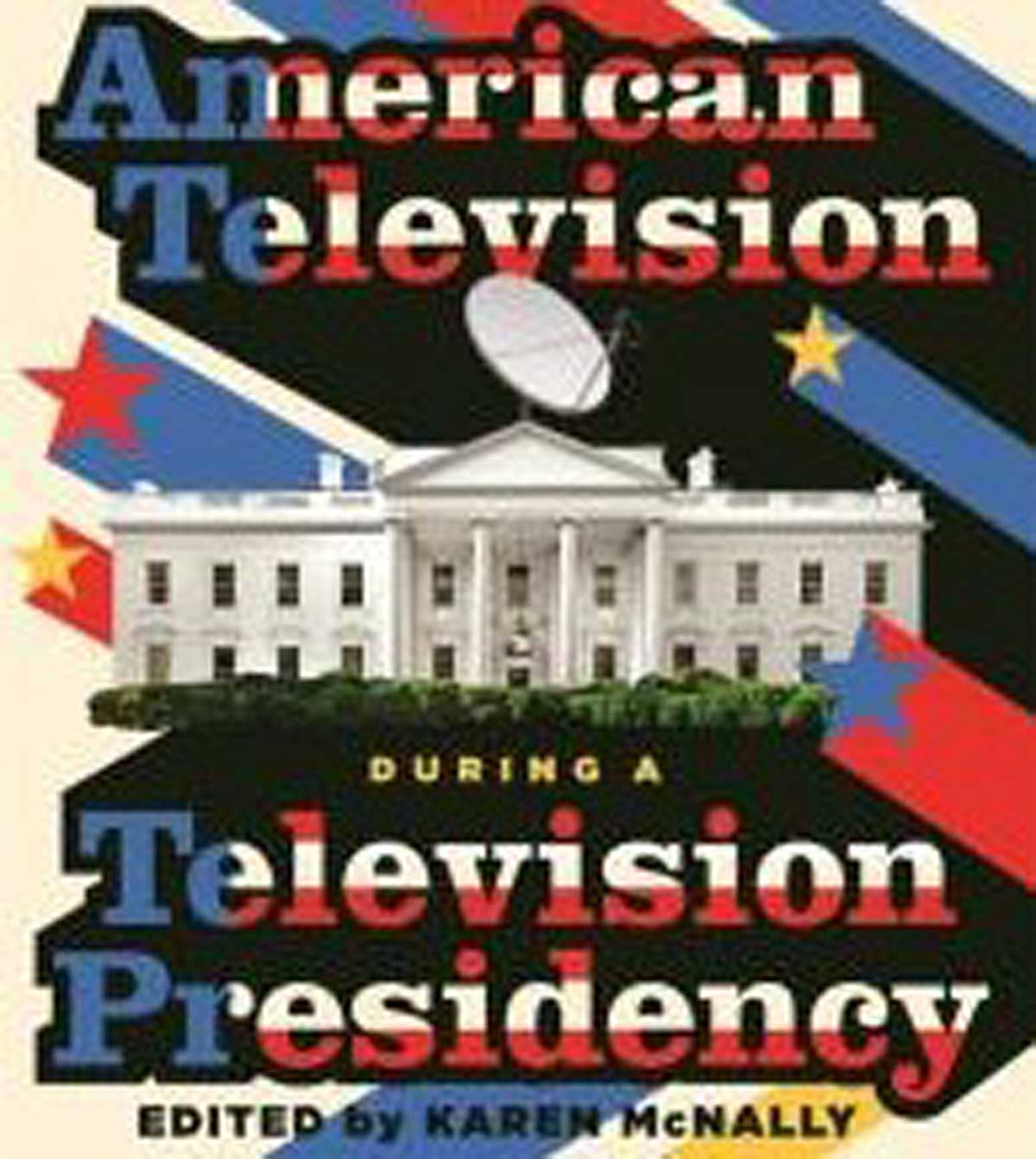Television and Donald J. Trump go hand in hand. From his alleged excessive consumption of the medium, to him being continuously mocked on late-night TV, over to the 24-hour news cycle’s fascination with (and complicity in the production of) the constant volatile spectacle of his presidency, there exists an intense and complex medial interplay between the American small screen and Donald Trump. With American Television during a Television Presidency (2022) editor Karen McNally makes a timely case for understanding the Trump Era and its disruptive cultural politics through the prism of television. McNally brings together sixteen exciting chapters across five thematic parts, covering much televised ground and a wide range of methodological approaches, to discover and interrogate how Trump has shaped contemporary television and how, in turn, television has reacted to his fraught image.
The first part, ‘Donald Trump and a Media Presidency’, sets the stage for the rest of the edited collection by illuminating the intimate entanglement of Trump and his televisual influences and representations. Martin Murray’s chapter on ‘The Imaginary President: Donald Trump’s Narcissism and American TV’ traces how Trump’s longstanding presence on the small screen, especially as host of the popular reality television series The Apprentice (NBC, 2004–2015), has established him as the ideal presidential candidate to harness brash media celebrity for a media presidency played out on the unrelenting TV news circus. Conversely, looking beyond Trump’s constructed self-images in the chapter ‘Our Cartoon President: Donald J. Trump’s White House as an Animated Comedy’, Rafał Kuś notes that the president’s avatar on the animated sitcom Our Cartoon President (Showtime, 2018–2020) transforms Trump into an ambivalent, humanized caricature.
The politics and subversive power of TV comedy and its idiosyncratic limitations are addressed in later parts of the book as well. Dolores Resano’s chapter ‘From Political Depression to “Satiractivism”: Late-Night in the Tribal Era of Trump’ sheds a light on how contemporary late-night talk shows attempt to promote satirical activism. Further, Michael Mario Albrecht argues in ‘First as Farce, Then as Tragedy: The Hilarious Nihilism of the Trump-Influenced Final Season of Veep’ that during this turbulent era the political comedy Veep (HBO, 2012–2019) ‘ran up against the limits of satire in its final season and ultimately took a dark and nihilist turn’ (188). Yet, far from signaling the end of comedy as we know it, these chapters emphasize the adaptability and importance of television in the face of the divisive Trumpian climate. Indeed, the edited collection as a whole considers television, humorous or not, as being the screen medium ideally suited for countering the Trump presidency and ongoing cultural turmoil with progressive social commentary.
Part two, on ‘Fact, Fiction, and Critique’, consolidates evocative investigations of television programs which dramatize the ways in which Trump and his politics loom impossibly large in American culture. In her chapter ‘The Political is Personal: Disturbing Form, Revisiting Liberalism, and Resisting Trump’s America in The Good Fight’, Karen McNally persuasively illustrates how the legal drama The Good Fight (CBS All Access/Paramount+, 2017–)—the opening scenes of which show the educated white liberal protagonist react in shock and terror to Trump’s presidential inauguration—‘depicts more directly than any of its television contemporaries the profound impact of the Trump presidency on the US climate’ (90). The effects of the relentless political chaos and its corresponding media feeding frenzy are, as McNally contends, reflected in the way that central characters in The Good Fight become slowly but surely consumed, overwhelmed, and radicalized by the contentious Trumpian zeitgeist.
In part three, the theme of liberal grief, critique, and anti-Trumpian action is further explored, albeit in a less explicit manner, through TV texts with variously strong generic stylings. Hannah Andrews and Gregory Frame’s chapter on ‘Teaching Demons and Eating Nazis: Morality in Trump-Era Fantasy Comedy’ delves into how the wider fantasy frameworks of Santa Clarita Diet (Netflix, 2017–2019) and The Good Place (NBC, 2016–2020) enable these comedies to act as allegorical vehicles for leftist critiques of contemporary politics. Examining the heated reception and social media backlash to Star Trek: Discovery (CBS/CBS All Access/Paramount+, 2017–), along with its diverse cast’s ‘actorvism’ (143), Teresa Forde outlines in her chapter ‘Star Trek: Discovery and Controversy: “The War Without, the War Within”’ how this legacy science fiction program serves as a self-conscious arena for utopian visions and ‘biased representations that directly challenge Trump’s presidency’ (147).
The next part, ‘Power and Gender’, uncovers more dynamic sites of televisual resistance. In the incisive chapter ‘“Grab Them by the Pussy”: The Sexual Politics of Touch in The Handmaid’s Tale’, Donna Peberdy teases out how cultural anxieties about women, feminism, and regressive Trumpian gender politics are played out and dramatically redressed in The Handmaid’s Tale (Hulu, 2017–), specifically through the nexus of touch. In a totalitarian regime wherein women’s rights, agency, and voices are severely policed, the reclaimed female touch, even the slightest one, can, according to Peberdy, operate as a means of defiance and hope.
This hopeful theme is carried over into the book’s final part through careful examinations of television texts which remember and reconsider the past. By exploring how collective memory is renegotiated across contemporary television, the contributors demonstrate how alternative futures can be imagined and realized. The final chapter ‘“The Cost of Lies”: Chernobyl, Politics, and Collective Memory’ focuses on HBO’s Chernobyl (2019). Although this historical drama is not concerned with a US catastrophe or setting, Oliver Gruner astutely observes that American audiences, including bestselling horror author Stephen King, interpret the program as ‘an ominous harbinger of struggles yet to be waged’ (305). The unflinching realist horror aesthetics, Gruner finds, mark Chernobyl as an urgent and convincing call to action against the disastrous Trump presidency, which, akin to the Soviet Union at the time of the devastating nuclear accident, is defined by post-truth politics, national disintegration, and governmental and environmental crisis. Perhaps more than anything else, this non-US-centric series underscores the extent to which, during the Trump years, American television was shaped and possessed by the president’s inescapable specter.
The appeal of American Television during a Television Presidency lies in the fact that it provides extensive insight into television during the Trump Era and the period’s polarizing cultural politics, as well as the distinct relationship between the two. McNally’s edited collection is a compelling and ambitious addition to the growing field of scholarship which seeks to make sense of Trump’s presidency; in this case, its televised Trumpian images. Throughout all chapters it becomes apparent that, at every turn, on any channel or streaming service, Trump, in some shape or another, finds the American televisual spotlight. As much as he is enthralled by watching television and his own appearances on it at all hours and across multiple screens and rooms in the White House, this edited collection reveals how the contemporary TV mediascape is just as adamantly in thrall to Trump.
Competing Interests
The author has no competing interests to declare.

